Alcazar at Seville: A Journey into Architectural Splendor and History
Visiting the Alcazar Seville, is where you experience history, art, and architectural grandeur converge to create a truly enchanting experience in one place. Nestled in the heart of Seville, Spain, the Alcazar stands as a testament to centuries of cultural influences, blending Islamic, Christian, and Mudéjar architectural styles into a stunning masterpiece. As you step into its intricate courtyards, lush gardens, and opulent halls, you embark on a journey through time, immersing yourself in the rich tapestry of Seville’s past. From the graceful arches and intricate tilework to the serene water features and lush greenery, every corner of the Alcazar exudes a sense of tranquility and magnificence. So come, wander through its halls, marvel at the ornate details, and let the Alcazar’s captivating beauty transport you to a bygone era of splendor and sophistication.
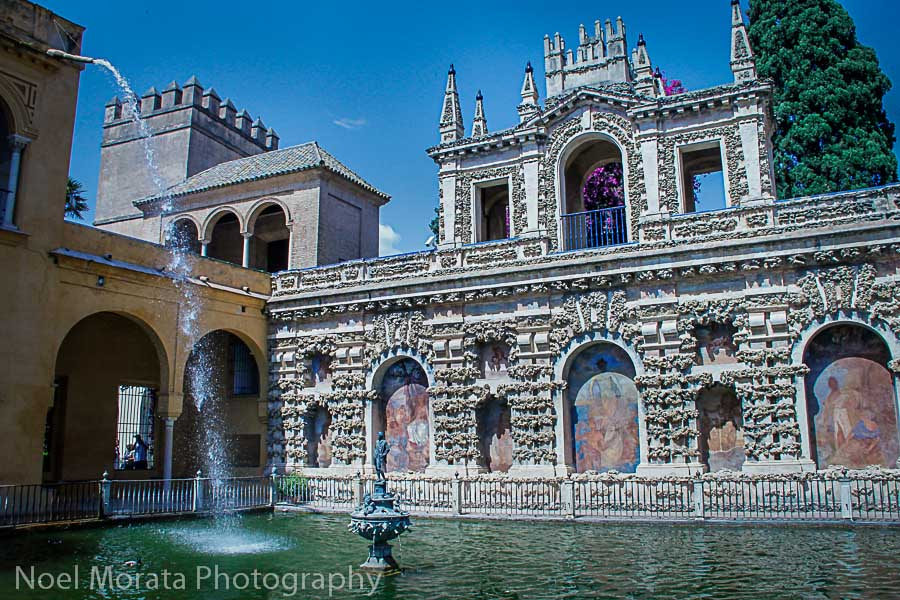
A brief history on the Alcazar Seville
The Alcazar or royal palaces of Seville were one the official palace of the Spanish royalty when they visited Andalucía and rule the four ancient capitals of Spain. It is the oldest royal palace still being used in existence in Europe and it has been registered as a Unesco World Heritage site in 1987. The upper floors of the palace are still used as a royal residence when the royal family is visiting Seville.
The palace is styled in the traditional mudejar architecture that was popular during the Spanish rule of Andalucía during the reign of King Peter who was also called the Sultan of Seville. Lavish interior rooms, reception and beautiful courtyards were built onto the palace with successive rules introducing new styles including Italian Renaissance and Baroque influences that were incorporated in the upper story and other locations from 1540 to completion in 1572.
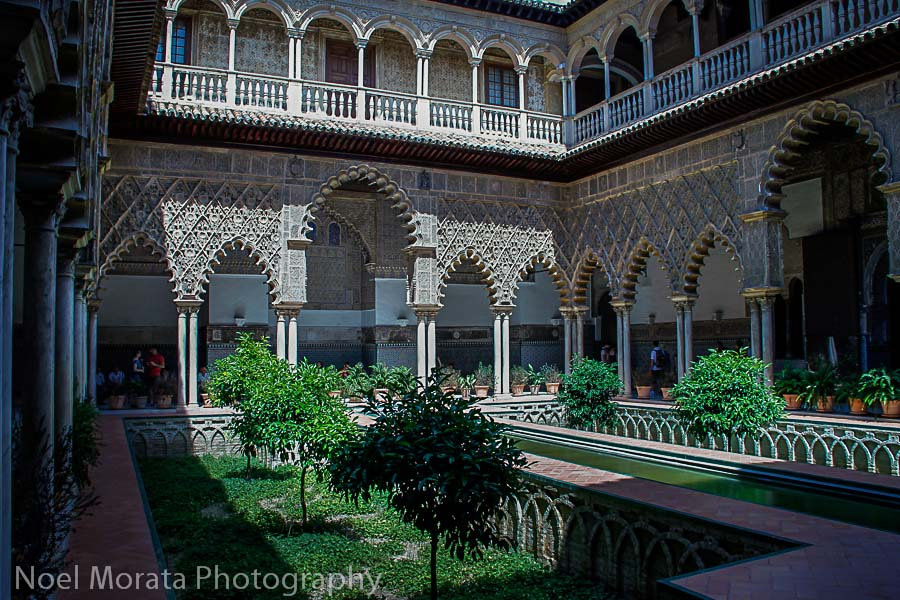
Directions on how to get to the Alcazar Seville
To reach the Alcazar of Seville, you can follow these directions:
Public Transportation: Seville has a well-connected public transportation system. If you are in the city center, you can take a bus or tram to the Alcazar. Look for buses/trams heading towards “Archivo de Indias” or “Puerta de Jerez” and get off at the corresponding stop. From there, the Alcazar is within walking distance.
Walking: If you are already in the city center, you can easily reach the Alcazar on foot. The palace is located near popular landmarks such as the Cathedral of Seville and the Plaza de España. Use a map or GPS to navigate through the charming streets of Seville towards the Alcazar.
Taxi: Taxis are readily available throughout Seville. Simply hail a taxi or head to a designated taxi stand and inform the driver that you want to go to the Alcazar. It’s a convenient option if you prefer a direct and hassle-free journey.
Car: If you’re driving to the Alcazar, it’s important to note that parking spaces in the city center can be limited. There are public parking lots available nearby, such as the parking facility at Plaza de España. From there, you can walk to the Alcazar.
Once you arrive near the Alcazar, you will find clear signage directing you to the entrance. Follow the signs and make your way to the ticket counter to purchase your entry tickets. It’s advisable to check the opening hours of the Alcazar in advance, as they may vary depending on the season.
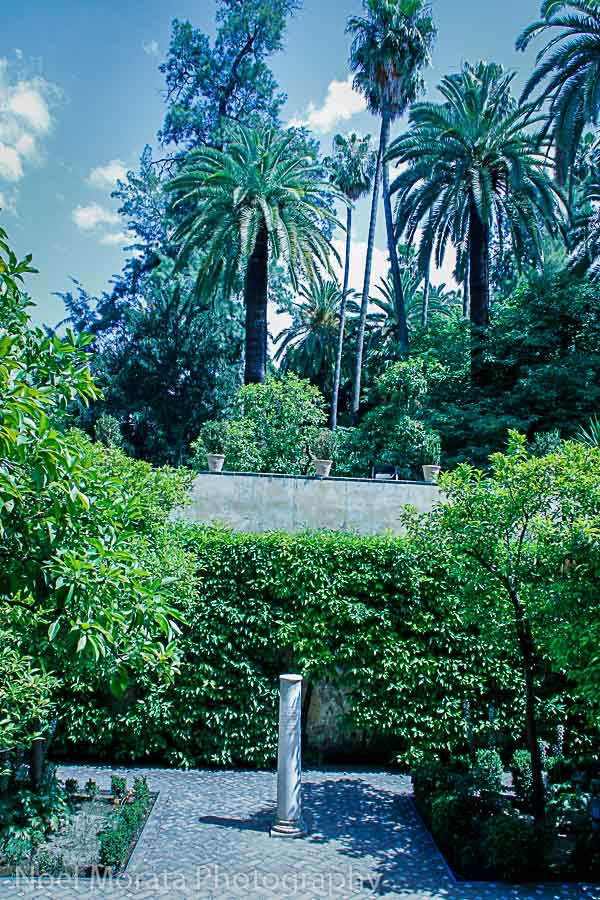
Guided tours visiting the Alcazar Seville
The Alcazar offers guided tours, but they are not complimentary. To join a guided tour, you would need to purchase a ticket specifically for the guided tour option. These guided tours provide valuable insights and information about the history, architecture, and significance of the Alcazar, enhancing your visit and understanding of the site. However, if you prefer to explore the Alcazar at your own pace and without a guide, you can opt for a regular entry ticket and explore independently. Audio guides are also available for rent at an additional cost, providing recorded commentary in multiple languages to further enrich your experience.
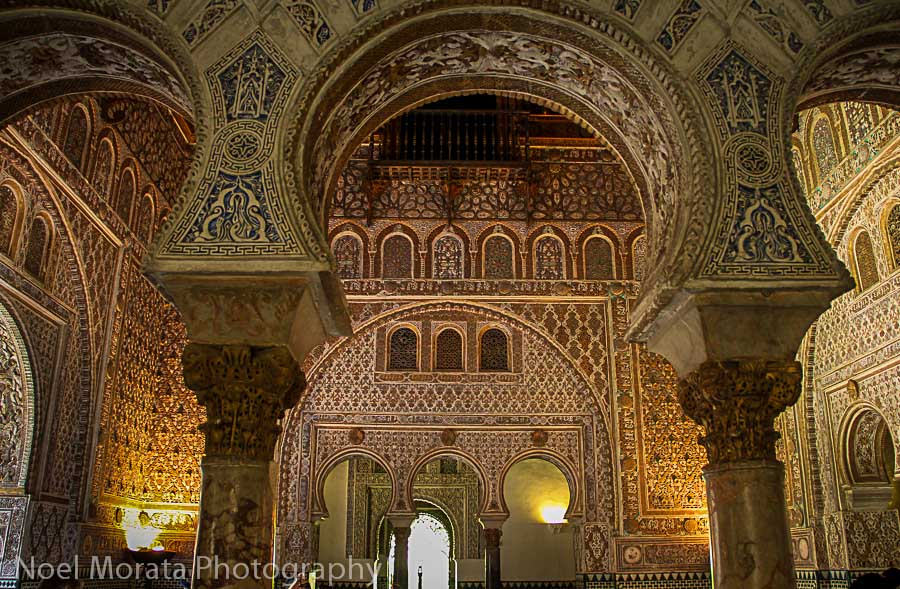
Design influences of the Alcazar Seville
The design influences of the Alcazar Seville reflect the complex history and cultural interactions of Seville and its rulers over the centuries. This unique fusion of architectural styles creates a visually stunning and culturally significant monument that continues to captivate visitors to this day.
Here are the main design influences to creating the Alcazar:
Islamic Influence: The Alcazar’s architecture showcases the profound influence of Islamic art and design, particularly from the Moorish period. The intricate geometric patterns, horseshoe arches, and decorative tilework known as azulejos are prominent features. These elements create a sense of harmony, elegance, and beauty throughout the Alcazar.
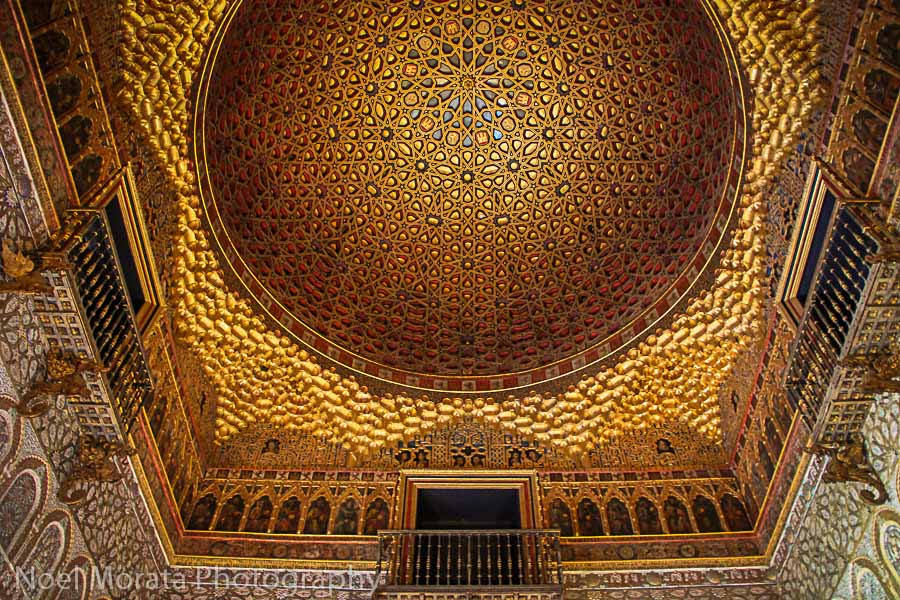
Mudéjar Influence: The Mudéjar style, which emerged during the period of Muslim rule in Christian territories, further contributed to the design of the Alcazar. Mudéjar elements can be seen in the delicate plasterwork, carved wooden ceilings, and the use of vibrant colors. This style seamlessly combines Islamic and Christian motifs, resulting in a unique aesthetic.
Gothic and Renaissance Influences: Over time, the Alcazar underwent additions and modifications, including elements of Gothic and Renaissance styles. These influences can be observed in certain areas, such as the Gothic Palace section and the majestic Hall of Ambassadors. The incorporation of pointed arches, ribbed vaults, and ornate detailing showcases the transition to these architectural styles.
Spanish Baroque Influence: During the 17th century, the Alcazar underwent renovations that introduced elements of the Spanish Baroque style. This can be seen in the extravagant ornamentation, richly adorned facades, and the ornate Salon of the Dolls (Salón de los Muñecos).
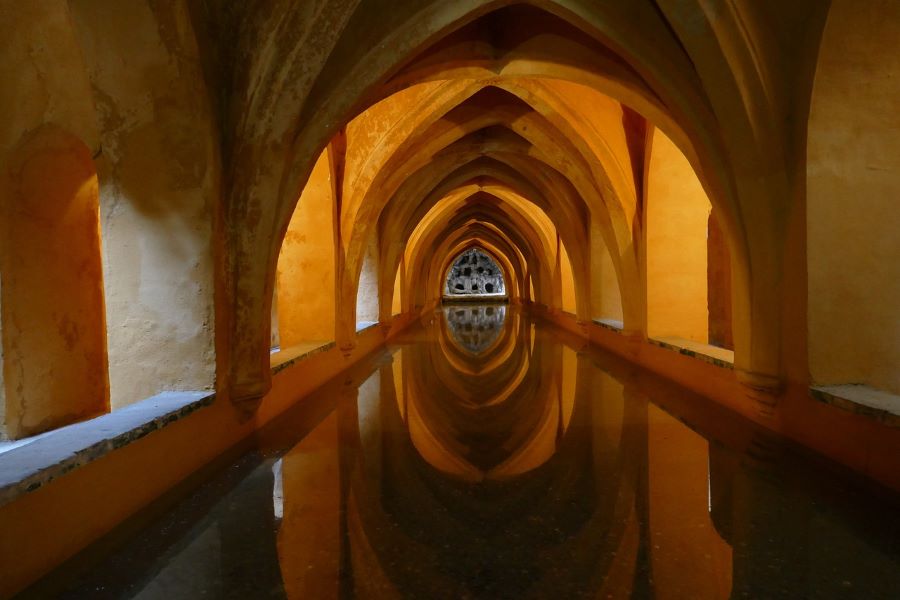
Grand Baths of the Alcazar
The Grand Baths of the Alcazar, also known as the Baños de Doña María de Padilla (Baths of Lady María de Padilla), are a striking feature within the Alcazar of Seville. These baths are known for their unique architectural design, historical significance, and intriguing legend associated with Lady María de Padilla. Here’s a description of the Grand Baths:
The Grand Baths are located beneath the Patio del Crucero, one of the courtyards within the Alcazar. These underground baths are a hidden gem that captivates visitors with its subterranean beauty. The baths consist of a series of interconnected vaulted chambers, creating an atmospheric and almost mystical ambiance.
The architecture of the baths showcases the distinct influence of Moorish design with its horseshoe arches, elegant columns, and intricate decorative elements. The use of brick and stone contributes to the baths’ robust structure while also adding to their aesthetic appeal. The rooms are organized in a linear fashion, with varying levels and interconnected pools.
The central feature of the Grand Baths is the rectangular pool that spans the length of the central chamber. The pool is surrounded by columns and arches, creating a colonnaded walkway that enhances the visual impact of the space. The water in the pool adds a reflective quality, enhancing the play of light and shadows on the surfaces.
One of the most captivating aspects of the baths is the legend associated with Lady María de Padilla, a woman of historical importance. According to the legend, King Peter the Cruel’s mistress, Lady María de Padilla, used to bathe in these baths. The legend further romanticizes the space, describing how the king ordered the construction of the baths to be dedicated to her. However, historical accuracy regarding the story is debated among historians.
Today, visitors to the Alcazar can explore the Grand Baths and experience the unique ambiance of this subterranean marvel. The combination of Moorish architectural elements, the enchanting legend of Lady María de Padilla, and the serene atmosphere of the baths make them a captivating and memorable part of the Alcazar’s historical and architectural heritage.
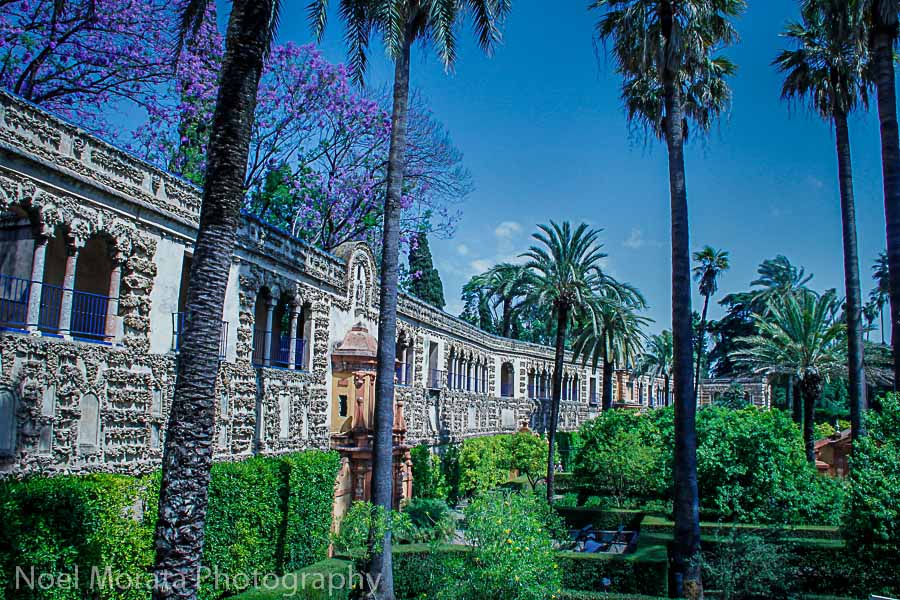
Gardens of the Alcazar Seville
The gardens of the Alcazar Seville are extensive with many water features, pavilion and fountains which were a primarily feature of gardens incorporating the popular mudejar style of that time frame. The grounds of the Alcazar gardens are extensive and are broken up into separate garden rooms below to enjoy and with a specific theme or garden style.
Here are some highlights and tips for exploring the gardens:
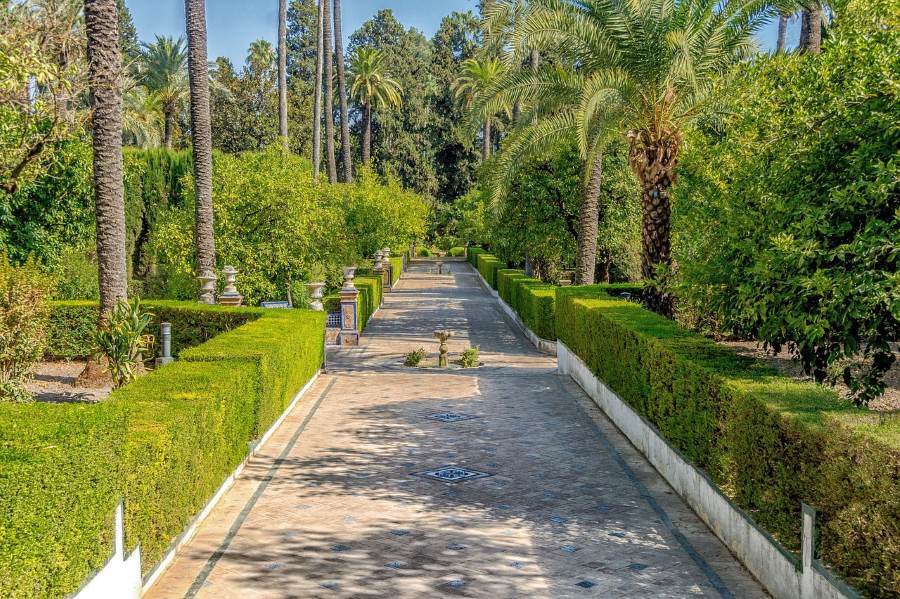
Exquisite Landscapes: The gardens of the Alcazar are renowned for their meticulously designed landscapes, combining elements of Islamic, Renaissance, and Mudejar styles. You’ll encounter a harmonious blend of lush greenery, vibrant flowerbeds, tranquil ponds, and meandering pathways that lead to hidden corners waiting to be discovered.
Key Garden Areas: As you explore, make sure to visit the notable garden areas within the Alcazar. The Garden of the Dance (Jardín de la Danza) showcases beautiful terraces, fountains, and orange trees, while the Garden of the Ladies (Jardín de las Damas) features intricate patterns of hedges and stunning geometric designs. The Garden of the Poets (Jardín de los Poetas) offers a serene atmosphere with its tranquil water features and fragrant blooms.
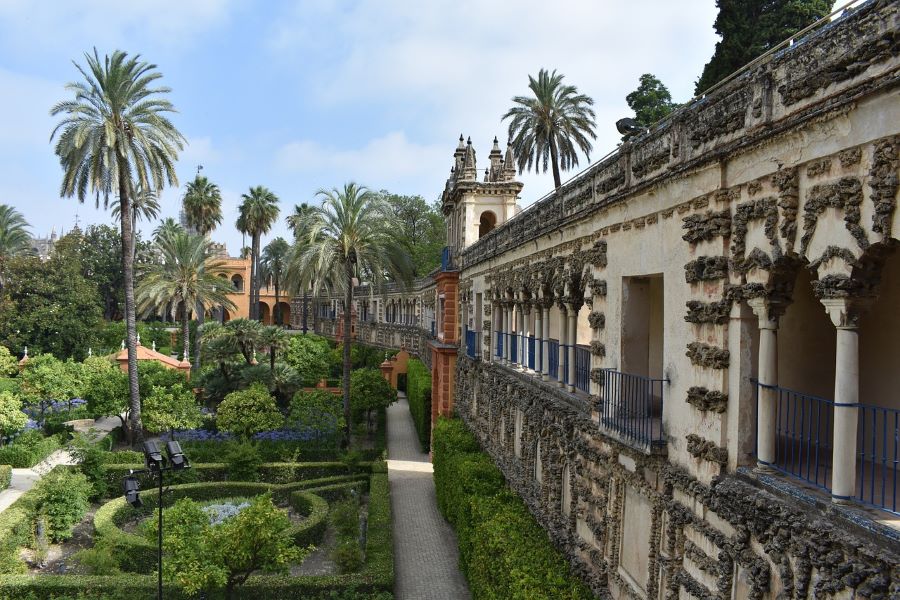
Pergola Walkways: Don’t miss the enchanting pergola walkways adorned with climbing plants and delicate flowers. These shaded passages create a romantic and picturesque ambiance, providing a cool respite on warm days.
Hidden Courtyards: Throughout the gardens, you’ll come across hidden courtyards and tranquil alcoves that offer peaceful retreats. Take a moment to relax, absorb the surroundings, and appreciate the intricate details that make these spaces so captivating.
Seasonal Displays: The gardens change with the seasons, offering different displays of colors and fragrances throughout the year. Spring brings vibrant blooms, while autumn presents a tapestry of warm hues. Every season offers a unique experience, so consider visiting during different times to witness the garden’s ever-changing beauty.
Photography and Relaxation: The gardens of the Alcazar provide excellent photo opportunities, so be sure to capture the picturesque landscapes and architectural details. Additionally, take the time to simply relax and soak in the tranquil atmosphere, finding a bench or quiet spot to unwind amidst the natural splendor.
Timing and Crowds: To avoid crowds and fully appreciate the tranquility of the gardens, consider visiting early in the morning or later in the afternoon. This allows for a more peaceful experience and better opportunities for exploration and reflection.
The Main gardens of the Alcazar
The garden of the poets
The Garden of the Poets (Jardín de los Poetas) in the Alcazar is a serene and captivating space that pays homage to the literary world. This enchanting garden beckons visitors with its peaceful ambiance and delightful features.
English garden
The English Garden in the Alcazar is a picturesque retreat that encapsulates the charm and natural beauty of traditional English gardens. , – built during 18th century with the door to the Alcoba which is Islamic in origin.
The English Garden boasts a harmonious blend of carefully manicured lawns, meandering pathways, and enchanting flower beds bursting with a kaleidoscope of colors. Roses, daisies, lavender, and a myriad of other blooming flowers create a tapestry of fragrances and visual splendor.
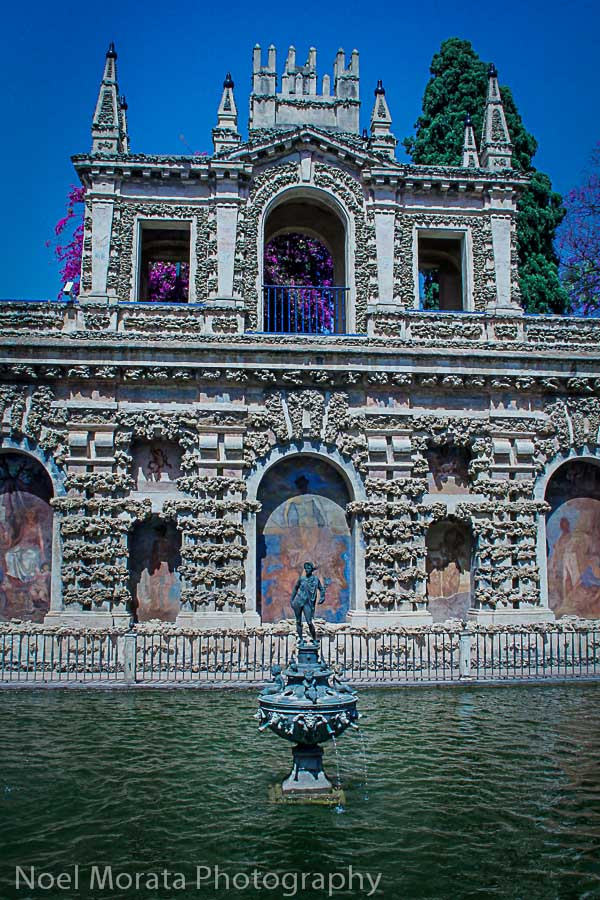
Jardin de la Alcubilla (Garden of the Reservoir)
The Jardin de la Alcubilla, or Alcubilla Garden, is a hidden gem within the Alcazar of Seville that offers a tranquil escape from the bustling palace grounds.
As you enter the Jardin de la Alcubilla, you are greeted by a charming courtyard adorned with a central fountain, its soothing sounds providing a serene ambiance. Surrounding the fountain, you’ll find an array of lush greenery, including carefully trimmed hedges and vibrantly colored flowers, creating a delightful visual feast.
The garden’s design reflects a fusion of elements from different periods, combining Islamic, Renaissance, and Mudéjar influences. Arched doorways, intricate tilework, and delicate sculptures add a touch of elegance and cultural richness to the garden’s overall aesthetic.
Meandering pathways lead you through the garden, inviting you to explore its hidden corners and serene alcoves. As you wander, you’ll encounter inviting benches and shaded areas where you can pause to appreciate the tranquility and immerse yourself in the garden’s peaceful atmosphere.
Jardin de la Vega (Garden of Vega Inclan)
The Jardin de la Vega, also known as the Vega Garden, is a picturesque green space located within the Alcazar of Seville. This delightful garden offers a serene and refreshing escape within the historic palace grounds. Here’s a description of the Jardin de la Vega:
The garden’s design showcases a harmonious balance between natural elements and carefully manicured features. You’ll discover meandering pathways that wind through expanses of vibrant lawns, inviting you to explore the garden’s hidden corners. Along the pathways, you’ll encounter fragrant flower beds bursting with a myriad of colors, from delicate roses and cheerful daisies to vibrant seasonal blooms.
I wrote about this garden being featured for upcoming episodes of the Game of Thrones featuring this location as the Kingdom of Dorne, you can view the here.
Interior Courtyards of the Alcazar, Seville
The Alcazar of Seville, a remarkable palace complex renowned for its stunning architecture and historical significance, features several interior courtyards that contribute to its unique charm. Here are some of the notable interior courtyards of the Alcazar:
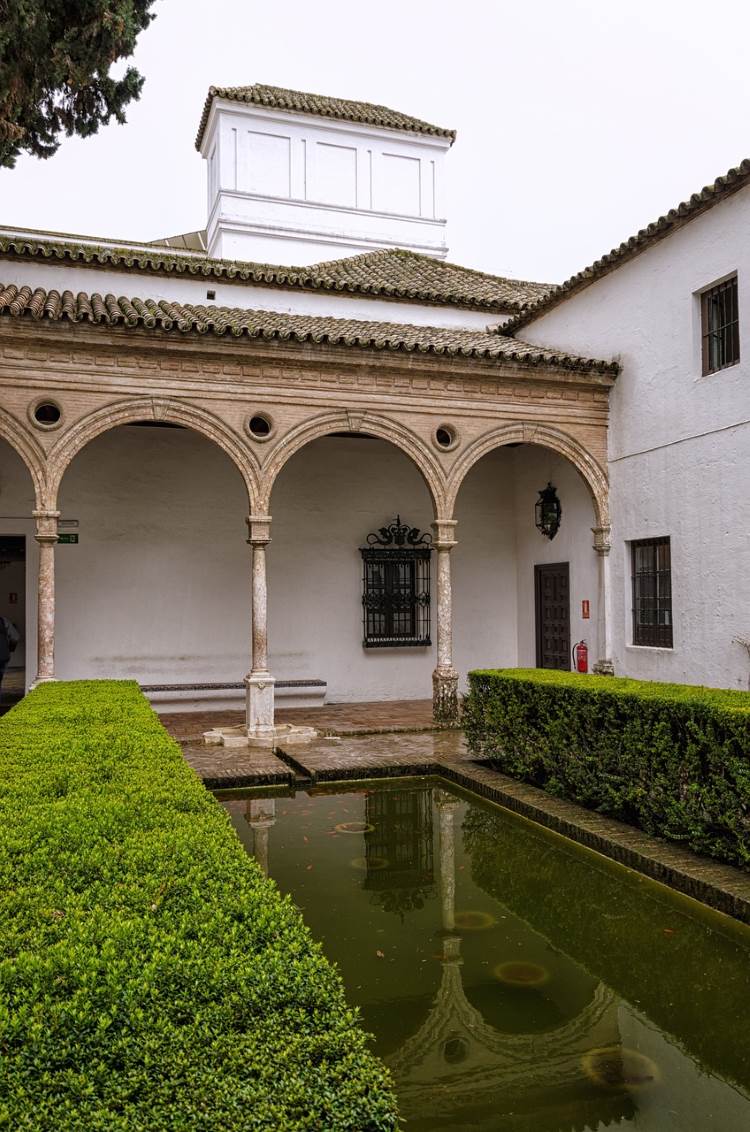
Patio del Yeso (Plaster Courtyard): This is the first courtyard visitors encounter upon entering the Alcazar. It derives its name from the white plaster used to decorate its walls. The courtyard features intricate Islamic architectural elements and lush gardens, blending both Moorish and Christian influences.
Patio de la Montería (Hunting Courtyard): Located just beyond the Puerta del León (Lion’s Gate), this courtyard has a more spacious and open feel. Its name refers to the fact that it was once used as a gathering point for royal hunting expeditions. The courtyard boasts grand archways, arcades, and a central fountain.
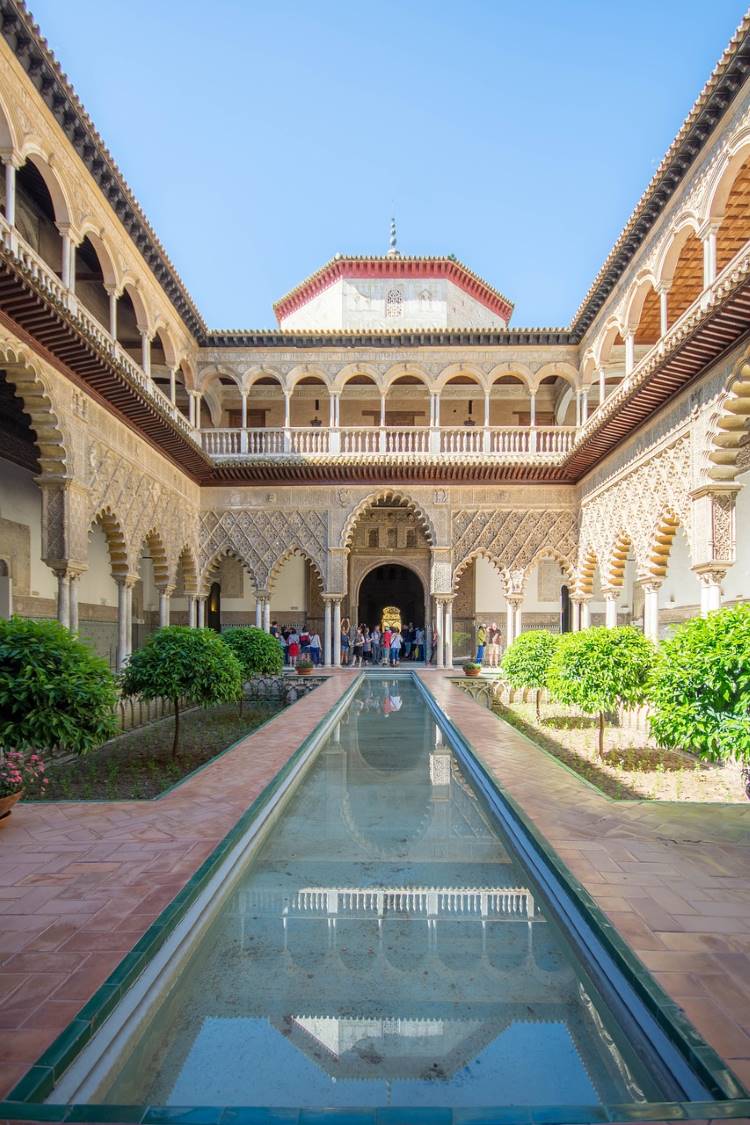
Patio de las Doncellas (Courtyard of the Maidens): Perhaps the most famous courtyard within the Alcazar, the Patio de las Doncellas is characterized by its exquisite stucco work, intricate tile patterns, and reflecting pool. The name “Maidens” refers to the tribute of Christian virgins given to the Moors during the Reconquista. This courtyard beautifully combines both Islamic and Mudéjar styles.
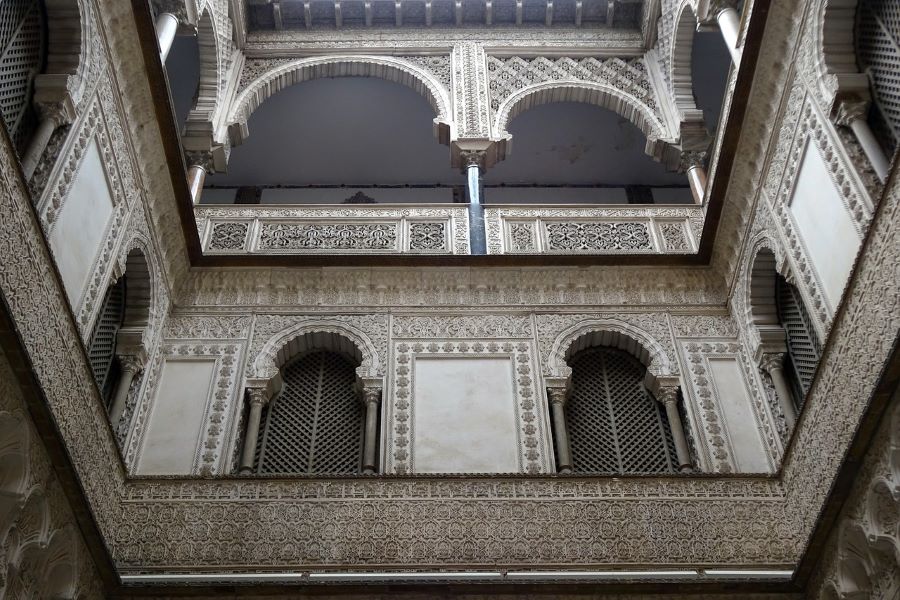
Patio de las Muñecas (Courtyard of the Dolls): Situated adjacent to the Patio de las Doncellas, this smaller courtyard features ornate arches and decorative details. Its name is believed to come from the small heads resembling dolls that adorn its walls.
Patio de las Banderas (Courtyard of the Flags): This courtyard is found at the northern end of the Alcazar and offers splendid views of the Giralda tower and the city of Seville. It’s named after the banners and flags that were displayed during royal ceremonies.
Patio del Crucero (Cross Courtyard): Located within the Gothic Palace section of the Alcazar, this courtyard features a central fountain and is surrounded by pointed arches and Gothic architectural elements.
Patio del Leoncito (Little Lion Courtyard): Also situated within the Gothic Palace, this small courtyard is named after a stone lion fountain at its center. It’s a quieter space compared to the larger courtyards.
These interior courtyards collectively showcase the architectural evolution of the Alcazar, reflecting its rich history of Islamic, Mudéjar, and Christian influences. The intricate designs, lush gardens, and tranquil water features make the Alcazar’s interior courtyards a highlight for visitors exploring this remarkable palace complex in Seville.
Weather and best times to visit the Alcazar in Seville
The weather and best times to visit the Alcazar in Seville largely depend on personal preferences and the type of experience you seek. However, here is some general information to consider:
Weather: Seville has a Mediterranean climate, characterized by hot summers and mild winters. The weather can be quite hot and dry during the summer months, with temperatures often exceeding 30°C (86°F). Winters are generally mild, with average temperatures ranging from 10-15°C (50-59°F). Spring (March to May) and autumn (September to November) offer pleasant temperatures, making them popular seasons to visit.
Best Times to Visit: To avoid the peak summer heat and larger crowds, the best times to visit the Alcazar are during the spring and autumn months. The mild temperatures during these seasons create a comfortable environment for exploring the palace and its gardens. Springtime, in particular, showcases blooming flowers and refreshing greenery, adding to the enchanting atmosphere. If you prefer quieter periods, consider visiting during weekdays or early mornings when the palace tends to be less crowded.
It’s worth noting that the Alcazar can be busier during special events, holidays, and weekends, so planning your visit accordingly can enhance your experience. Additionally, checking the official website or contacting the Alcazar directly for any updates or specific recommendations regarding visiting times is always a good idea.
Check out these other posts to visiting Seville in Andalusia
Final thoughts to visiting the Alcazar Seville
I hope you enjoyed your visit to the Alcazar Seville, check out the official website here for more information to visiting the Alcazar of Seville.
Address: Patio de Banderas, s/n, 41004 Sevilla, Spain
Hours: Monday -Sunday from 9:30am to 5pm
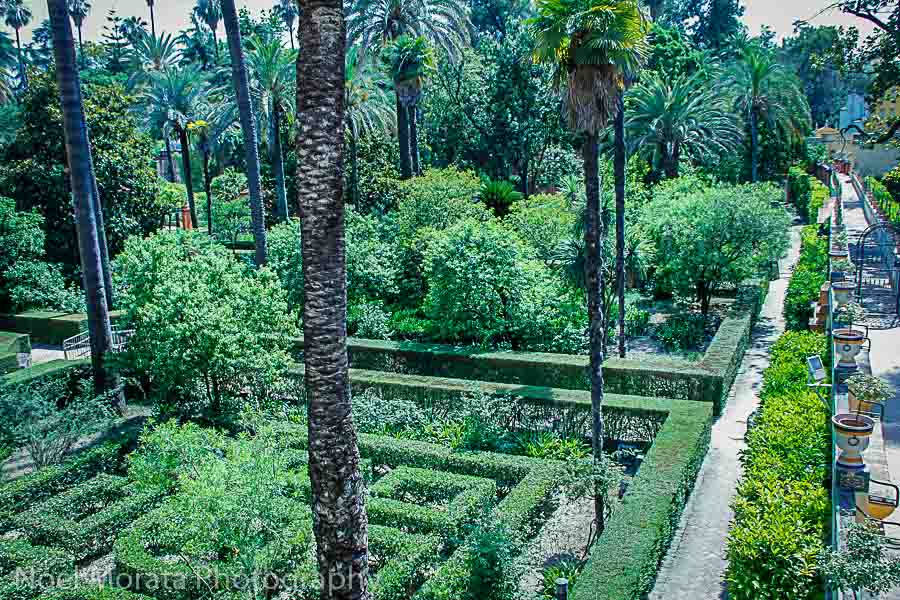
Conclusion to visiting the Alcazar Seville
Visiting the Alcazar in Seville is a captivating journey into history, art, and natural beauty. From the grand architecture and intricate details of the palace to the serene gardens that surround it, this iconic landmark offers a truly enchanting experience.
Exploring the Alcazar allows you to immerse yourself in centuries of rich heritage, marvel at the stunning Moorish and Renaissance influences, and appreciate the craftsmanship that went into creating this architectural masterpiece. Each room and courtyard tells a story, transporting you to a bygone era and offering glimpses into the lives of those who once inhabited this grand residence.
The gardens of the Alcazar are a tranquil paradise, with their lush greenery, fragrant flowers, and soothing water features. Whether strolling through the meticulously designed landscapes or finding a quiet spot to reflect, the gardens provide a sense of serenity and rejuvenation.
Thanks for checking out this post on Alcazar, Spain with Visiting Spain and Mediterranean.com, hope that this was helpful for planning a visit with things to do, attractions and other fun places to explore. Please come back again for more adventures in Spain and the Mediterranean coast.

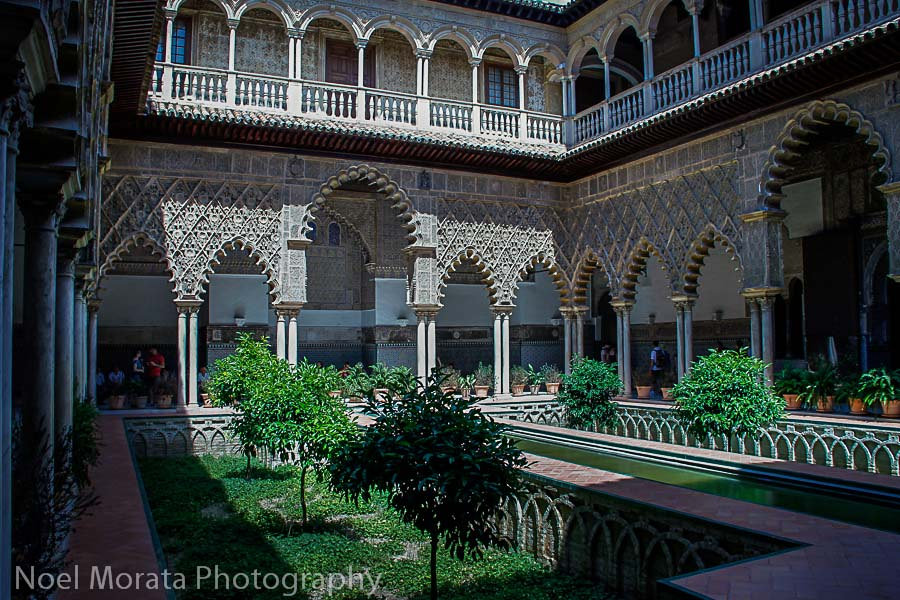
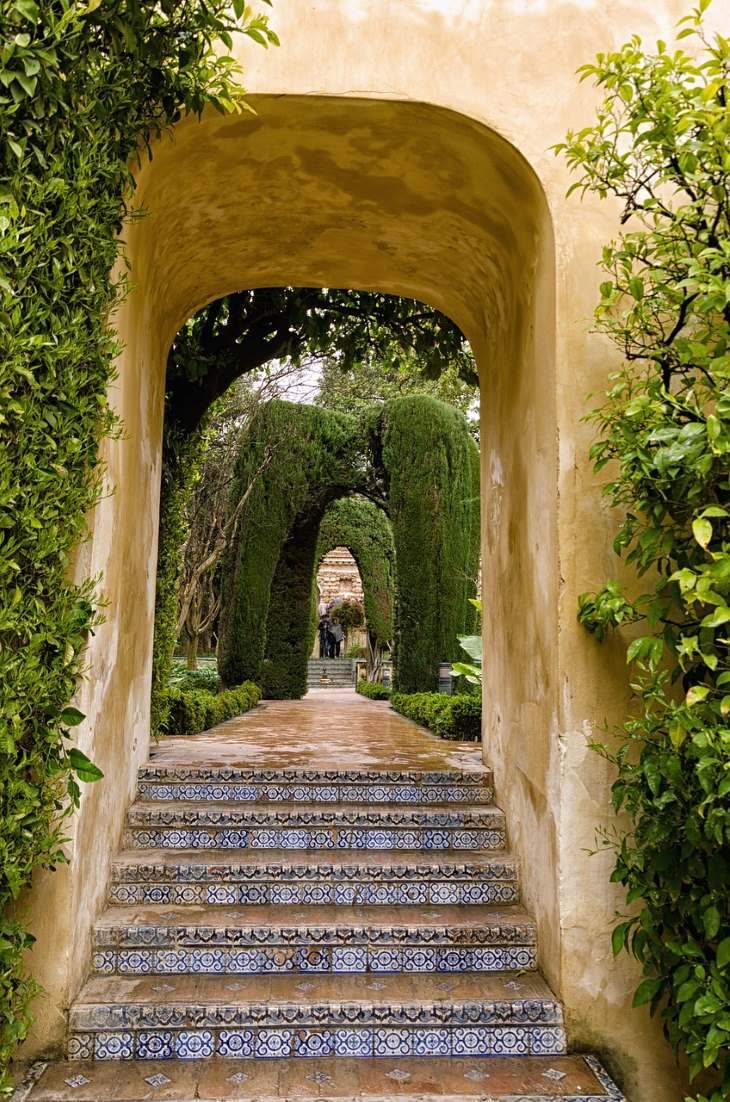
3 thoughts on “Alcazar Seville”